Why this resume works
- Quantifies accomplishments: Clearly quantifies accomplishments by citing specific metrics that demonstrate the job seeker’s extensive experience and reliability as a pilot, such as logging over 3,000 flight hours.
- Showcases career progression: The job seeker’s career progression from flight instructor to pilot is well-documented, with each role showing increased responsibilities and leadership in various aspects of flight operations.
- Uses action-oriented language: Strong action verbs like “maintained,” “coordinated,” and “assessed” highlight the job seeker’s proactive contributions and leadership throughout their career.
More Pilot Resume Examples
Explore more pilot resume examples to learn how to highlight your flight experience, technical proficiency, and safety record. These samples will help you create an aviation resume that stands out to hiring managers.
Entry-Level Pilot
Why this resume works
- Centers on academic background: The education section spotlights academic achievements with clear degree details, effectively emphasizing the job seeker’s foundational knowledge in aviation.
- Touches on accomplishments: Accomplishments like achieving a 95% pass rate for students taking the PPL exam underscore the job seeker’s exceptional performance and contributions within the aviation field.
- Shows flight training: The job seeker’s relevant flight training and commercial pilot license highlight a solid grasp of essential skills necessary for modern flight operations.
Mid-Level Pilot
Why this resume works
- Includes a mix of soft and hard skills: This resume balances technical prowess and interpersonal skills, evident in roles from flight assistant instructor to commercial pilot.
- Demonstrates management abilities: Skills such as crew resource management and flight planning and navigation reflect the job seeker’s ability to effectively manage flight operations.
- Clear contact information: Clear contact details in the resume header make it easy for employers to get in touch, ensuring no barriers to a quick callback.
Experienced Pilot
Why this resume works
- Showcases impressive accomplishments: The resume showcases impressive accomplishments by detailing significant achievements such as completing 1500+ flight hours incident-free and reducing fuel costs by 15%.
- Focuses on work history: This resume uses a chronological format to highlight extensive experience and career progression, ideal for a seasoned professional.
- Emphasizes leadership skills: Emphasizes leadership skills through examples like training new pilots, which improved team efficiency by 25%, and developing effective training modules.
Pilot Resume Template (Text Version)
DARRYL MASON
example@example.com | 555-555-5555 | Lexington, KY 40502
Professional Summary
Aviation professional, prepared for new challenges. Extensive experience in flight management and operational safety. Known for collaborative approach and reliable performance under varying conditions. Proficient in navigational systems and emergency protocols.
Work History
May 2016 – Current
Pilot
Blue Sky Airlines – Lexington, KY
- Thoroughly check weather conditions, airports, and other facilities along the planned route.
- Accurately complete post-trip paperwork and make adjustments to navigation charts, and aircraft manuals as necessary.
- Conduct minimum twice-daily preflight inspections and reviews of aircraft maintenance status.
Jan 2009 – Apr 2016
Pilot – First Officer
Blue Sky Airlines – Lexington, KY
- Greet boarding passengers, answer questions, provide assistance with baggage, or miscellaneous issues if needed.
- Maintained flight proficiency and knowledge of aircraft systems by attending monthly simulator and ground training.
- Assumed captain duties over 30 times due to captain unavailability or incapacitation.
Aug 2004 – Dec 2008
Flight Instructor
Lexington Flight Center – Lexington, KY
- Coordinated and executed student instruction schedules six days per week.
- Instructed students in simulator, live flight, and classroom environments.
- Assessed students’ operation or understanding of aerodynamics, aircraft navigation, radio operation, and emergency procedures.
Skills
- Modern aviation and aircraft technology
- Excellent communication skills
- Management and leadership abilities
- 3,000+ flight hours
- Teamwork and collaborative skills
- Spatial awareness
- Ability to remain calm under pressure
- Checklists understanding
Education
License: Commercial Pilot
Wings Flight Training | Danville, KY
- Completed rigorous training in flight operations, navigation, and aviation safety procedures.
- Acquired over 3,000 flight hours, demonstrating proficiency in modern aircraft technology, emergency protocols, and checklists.
Popular Skills for a Pilot Resume
A strong resume skills section is essential for highlighting both technical expertise and key soft skills. Pilots must have excellent flying capabilities along with effective communication, teamwork, and problem-solving skills to maintain safety and efficiency.
Below are a few of the top soft skills frequently listed on pilot resumes.
| Soft Skills | % of resumes with this skill |
|---|---|
| Time and task management | 39.19% |
| Decision making and problem solving | 17.74% |
| Documentation skills | 7.89% |
| Performance and limitations awareness | 6.25% |
Here are a few examples of hard skills frequently included on pilot resumes.
| Hard Skills | % of resumes with this skill |
|---|---|
| Crew resource management | 30.14% |
| Glass cockpit familiarity | 22.97% |
| Weather analysis and interpretation | 21.62% |
| Aircraft systems knowledge | 18.18% |
| Navigation | 12.50% |
Related Resume Guides
Advice for Writing Your Pilot Resume
Explore our advice section on how to write a resume for a pilot position. Discover tailored tips to help you effectively highlight your flight experience, certifications, and skills to land your dream job faster.
Highlight relevant technical skills
Technical skills are essential for a pilot, ensuring safe and efficient flight operations. To showcase these abilities effectively, consider creating a dedicated technical skills section on your resume. This approach helps employers quickly identify your qualifications. Alternatively, integrate technical skills into your work experience section by mentioning specific instances where you applied them.
Key technical skills for pilots include proficiency in using flight management systems (FMS), GPS navigation, and autopilot systems. Additionally, knowledge of aircraft maintenance procedures, understanding of weather radar systems, and the ability to conduct thorough pre-flight inspections are essential. Mentioning certifications such as an Airline Transport Pilot License (ATPL) or Type Ratings for specific aircraft can enhance your credibility.
When listing your technical skills, use bullet points for clarity and be specific about the technologies or equipment you’re proficient with. For example: “Experienced with Boeing 737 FMS,” “Skilled in using Jeppesen charts,” or “Proficient in conducting IFR operations.” Highlight achievements demonstrating your expertise, such as managing emergencies or optimizing fuel efficiency during flights.
Example of a technical skills section
- Flight Planning & Navigation
- Aircraft Systems Management
- Weather Analysis & Interpretation
- Instrument Flight Rules (IFR) Operations
- Visual Flight Rules (VFR) Operations
- Aviation Safety Protocols
- Air Traffic Control Communication
- Cockpit Resource Management (CRM)
- Emergency Procedures & Simulations
- Electronic Flight Bag (EFB) Usage
Highlighting soft skills like problem-solving, communication, and teamwork on your resume is key to showing how you can succeed in the workplace.
Quantify your accomplishments
Quantifying your accomplishments as a pilot makes your resume more compelling by showing exactly how you made an impact. Instead of listing job duties, such as “flew commercial aircraft,” include measurable achievements like “safely flew over 1,000 hours with a 98% on-time arrival rate.” By including numbers, percentages, and other metrics, you help hiring managers see the real impact of your work quickly.
List each job in your work experience section, followed by the employer’s name, location, and employment dates. Underneath each entry, turn your duties into achievements using action verbs and specific results.
For example: “Reduced fuel consumption by 5% through efficient flight planning,” or “Trained 20 new pilots resulting in a 15% improvement in overall team performance.”
This method creates a results-driven resume that clearly highlights your skills and contributions. Quantified accomplishments help hiring managers understand your capabilities at a glance and can set you apart from other candidates.
5 pilot work history bullet points
- Conducted pre-flight inspections and checklists for over 1,200 flights, ensuring zero safety violations.
- Led a crew of 5 flight attendants during international flights, enhancing passenger satisfaction scores by 25%.
- Executed precise takeoffs and landings in various weather conditions, maintaining a 100% incident-free record.
- Optimized fuel consumption strategies, resulting in a 10% reduction in operational costs annually.
- Trained and mentored junior pilots, contributing to a 15% improvement in overall team performance.
Check out our professional resume examples to get ideas and make your resume shine.
Write a powerful professional summary
A professional summary is a brief statement at the top of your resume that highlights your skills, experience, and achievements. For a pilot, this section should make a strong first impression by showcasing your flying hours, certifications, and any special training received. The goal is to quickly grab the attention of hiring managers and show them why you are the best candidate for the job.
If you are an experienced pilot, use a professional summary to emphasize your years of flying experience, types of aircraft piloted, and specific accomplishments like safety records or advanced training. If you are new to the field with limited work experience, opt for a resume objective instead. This will focus on your goals and what you aim to achieve in your aviation career while highlighting relevant skills like attention to detail and quick decision-making.
When writing this section, use action-oriented language such as “achieved,” “led,” or “managed” to underscore your impact. Tailor each point specifically to the pilot role you’re targeting to demonstrate how well-suited you are for the position.
Pilot resume summary examples
Entry-level
Newly graduated pilot with a Bachelor of Science in Aviation and an FAA Commercial Pilot Certificate. Proficient in flight planning, navigation, and aircraft systems. Completed over 250 hours of flight training, including night flying and cross-country operations. Known for strong problem-solving skills, attention to detail, and a commitment to safety.
Mid-career
Experienced pilot with over 6 years in commercial aviation, logging over 4,000 flight hours on various aircraft, including Boeing 737 and Airbus A320. Adept at managing complex flight operations, ensuring compliance with all regulatory requirements, and providing exceptional customer service. Recognized for excellent decision-making skills during high-pressure situations and maintaining impeccable safety records.
Experienced
Seasoned airline captain with 20+ years of experience and over 12,000 flight hours across international routes on wide-body jets such as the Boeing 777. Demonstrated leadership in training new pilots and enhancing operational efficiency through strategic planning. Holds an ATP certificate with multiple type ratings and is known for optimizing crew performance while prioritizing passenger safety and comfort.
Pilot resume objective examples
Recent graduate
Recent aviation graduate with a strong academic background and hands-on flight training seeking an entry-level pilot position. Eager to apply technical skills, safety knowledge, and enthusiasm for aviation to contribute to a dynamic airline or charter service. Committed to continuous learning and professional growth within the field.
Career changer
Dedicated military veteran transitioning into civilian aviation with comprehensive flight training and operational experience. Highly motivated to leverage disciplined approach, exceptional problem-solving skills, and commitment to safety in a commercial pilot role. Ready to bring strong leadership abilities and a passion for flying to a reputable airline.
Specialized training
Licensed commercial pilot with multi-engine rating and advanced certifications in instrument flight rules (IFR) seeking an opportunity with a forward-thinking airline. Passionate about providing high safety standards, reliability, and customer service while contributing innovative solutions and teamwork in a fast-paced aviation environment.
Opt for a straightforward resume template featuring clear headings and readable fonts. Avoid excessive design elements to ensure it’s professional and recruiter-friendly.
Showcase your credentials
Listing your credentials is essential, especially when applying for technical roles like a pilot. Certifications, licenses, and specialized training show that you have the necessary skills and knowledge to do the job safely and effectively. These credentials can set you apart from other candidates by proving your expertise and dedication to your field.
Create a dedicated certifications section on your resume to list these important credentials prominently. For example, industry-recognized certifications might include FAA Airline Transport Pilot (ATP) License, Instrument Rating (IR), Multi-Engine Rating (MER), or Certified Flight Instructor (CFI).
Be sure to list each certification clearly with its full name and the issuing organization. Organize your sections neatly and highlight achievements within each credential if possible. For instance, mention any honors received during training or specific skills mastered. This approach makes it easy for employers to see your qualifications at a glance and understand quickly why you are the best fit for the pilot position.
Example of a certifications section
Airline Transport Pilot License (ATPL)
Issued by: Federal Aviation Administration (FAA)
Issued 2021
Certified Flight Instructor (CFI)
Issued by: Federal Aviation Administration (FAA)
Expires 2025
Multi-Engine Rating
Issued by: Federal Aviation Administration (FAA)
Issued 2019
Instrument Rating
Issued by: Federal Aviation Administration (FAA)
Issued 2018
You can use our Resume Builder to create your pilot resume. It helps you highlight your skills and experience quickly with easy-to-use templates.
Salary Insights for Pilots
Top 10 highest-paying states for pilots (new data)
Pilots earn varying salaries across the United States, with a national average of $140,656. The table below highlights the states where pilots command the highest compensation.
Our salary information comes from the U.S. Bureau of Labor Statistics’ Occupational Employment and Wage Statistics survey. This official government data provides the most comprehensive and reliable salary information for writers across all 50 states and the District of Columbia. The figures presented here reflect the May 2025 dataset, which is the most recent available as of this publication.
| State | Average Salary |
|---|---|
| Wyoming | $154,970 |
| Nevada | $149,230 |
| Oklahoma | $134,230 |
| North Dakota | $132,640 |
| Idaho | $124,710 |
| Arizona | $121,860 |
| Mississippi | $120,580 |
| Maryland | $117,350 |
| Louisiana | $115,190 |
| Kansas | $110,860 |
FAQ
Do I need to include a cover letter with my pilot resume?
Adding a cover letter to your pilot resume can give you a valuable edge, even when it’s not required. It’s your chance to go beyond the bullet points and explain why you’re genuinely interested in the airline or aviation company.
You can also highlight specific experiences that make you a strong fit, such as flying aircraft types used by the company or handling complex routes and challenging weather conditions. A cover letter allows you to express enthusiasm for the company’s mission, culture, or destinations.
While optional, a thoughtful cover letter can help set you apart in a competitive job market. For help getting started, check out our cover letter examples or use our Cover Letter Generator for personalized content suggestions and expert tips.
How long should a pilot’s resume be?
A pilot’s resume should typically be one page long, as this concise format allows hiring managers to evaluate your qualifications and experience quickly. However, if you have extensive flying hours, advanced certifications, or significant leadership roles in aviation, a two-page resume can be acceptable to showcase your expertise fully.
Focus on highlighting your flight experience, types of aircraft flown, key certifications, and any notable achievements. Prioritize recent and relevant information to ensure your resume length is impactful and easy to read.
How do you write a pilot resume with no experience?
When creating a resume with no experience, highlight your education, training, and any relevant skills that showcase your potential as a pilot. Here are a few tips to get started:
- Start with your education: Highlight your degree in aviation or related fields, including the institution name, graduation date, and any honors received. This demonstrates the foundational knowledge required for the role.
- Emphasize flight training: Detail your flight school experience by specifying the types of aircraft you’ve trained on and the number of flight hours completed. Mention any certifications or licenses obtained, such as a Private Pilot License (PPL) or Commercial Pilot License (CPL).
- Include relevant skills: List key pilot skills like strong communication abilities, problem-solving under pressure, attention to detail, and teamwork. These can be demonstrated through other jobs or volunteer work, even if they are not directly related to flying.
You can also include participation in aviation clubs and simulation training experiences to demonstrate your dedication and passion for becoming a pilot.
Rate this article
Pilot
Additional Resources
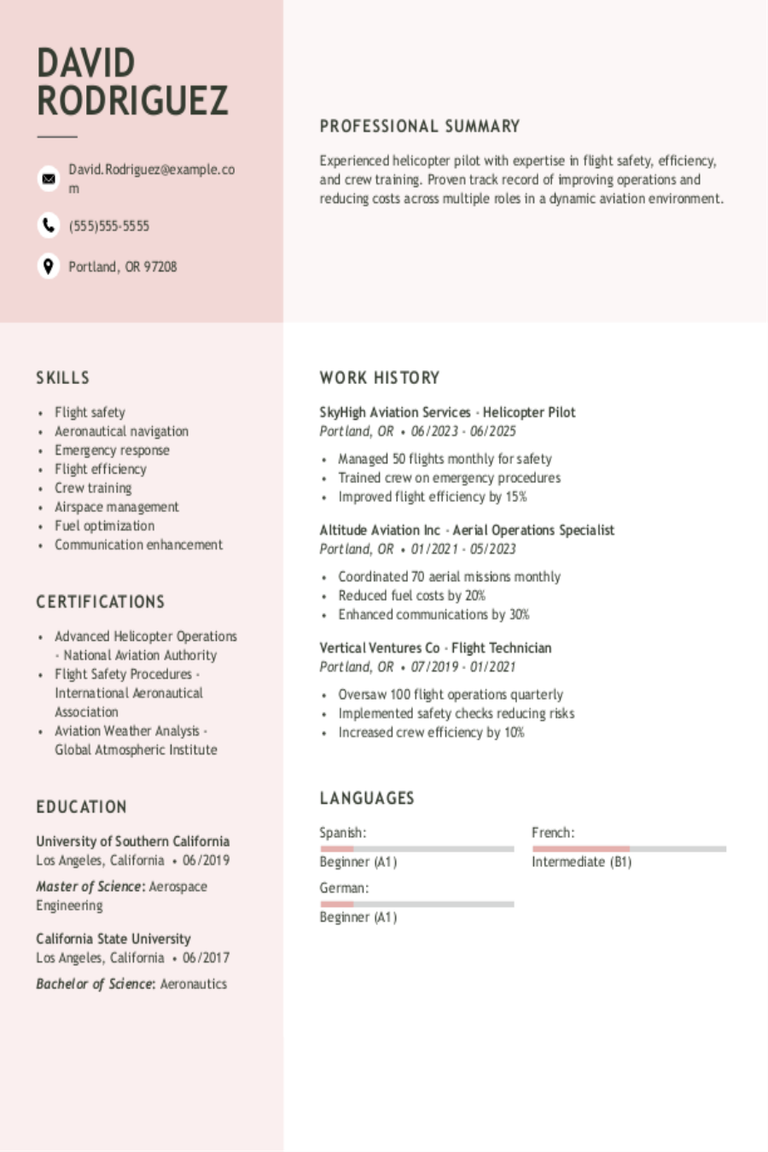
Helicopter Pilot Resume Examples & Templates for 2025
Explore helicopter pilot resume examples and tips to learn how to highlight your flying skills, safety record, and quick decision-making.Build my resumeImport existing resumeCustomize this templateWhy this resume worksHighlights
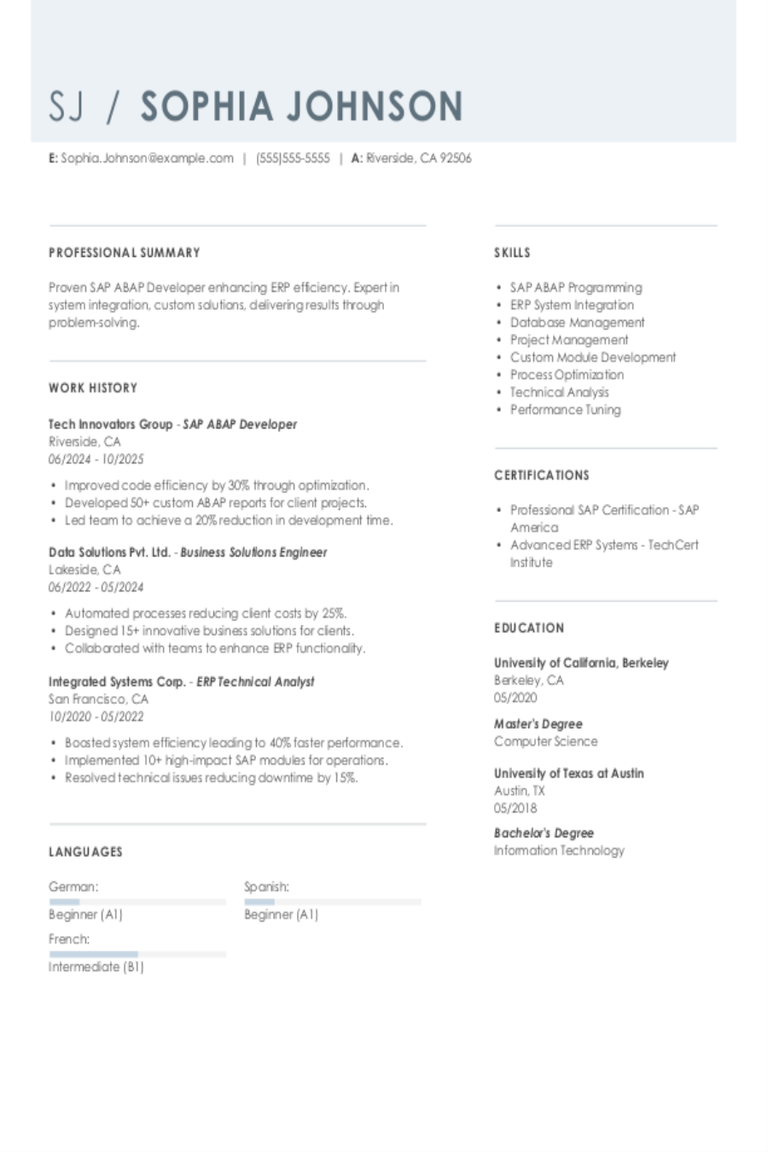
SAP ABAP Developer Resume Examples & Templates for 2025
Explore SAP ABAP developer resume examples and tips to learn how to spotlight your skills in coding, debugging, and system enhancements to stand out to hiring managers.Build my resumeImport existing
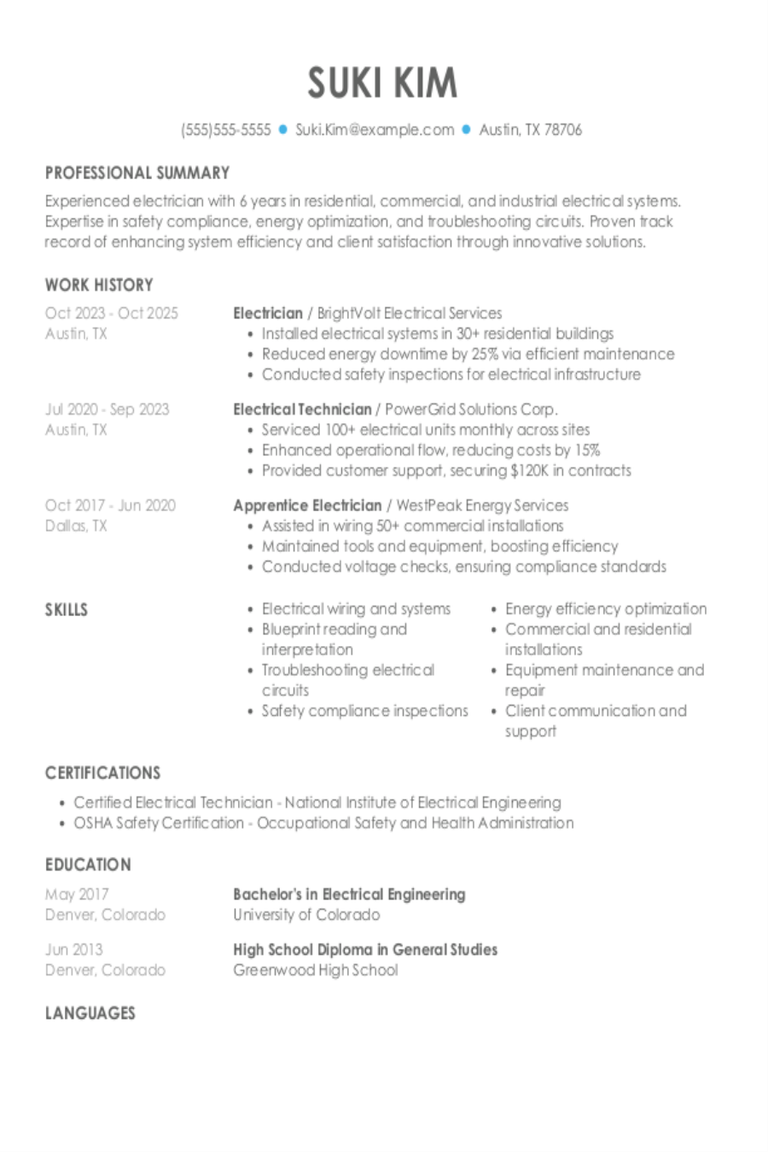
Electrician Resume Examples & Templates for 2025
Explore electrician resume examples to learn how to spotlight your wiring, troubleshooting, and safety skills. See how to emphasize your knowledge of electrical codes and highlight your experience across various
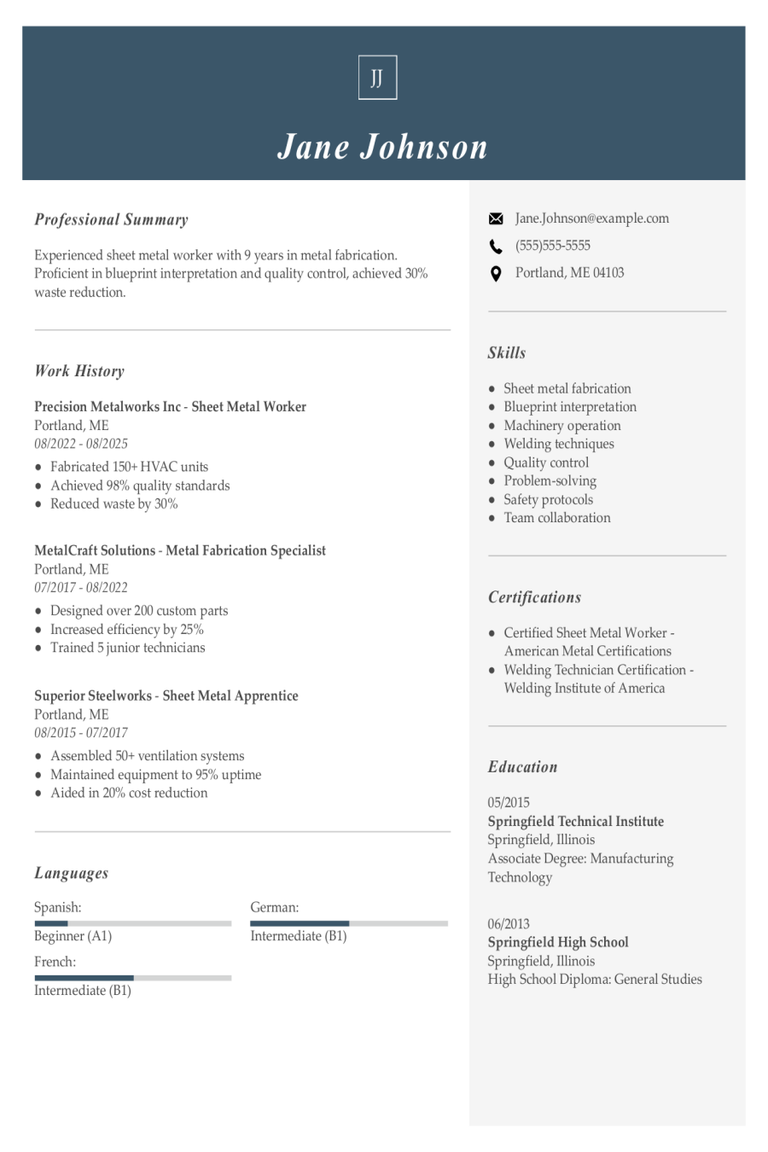
Sheet Metal Worker Resume Examples & Templates for 2025
Browse sheet metal worker resume examples and tips to learn how to highlight your hands-on experience and problem-solving abilities to stand out to recruiters and hiring managers.Build my resumeImport existing
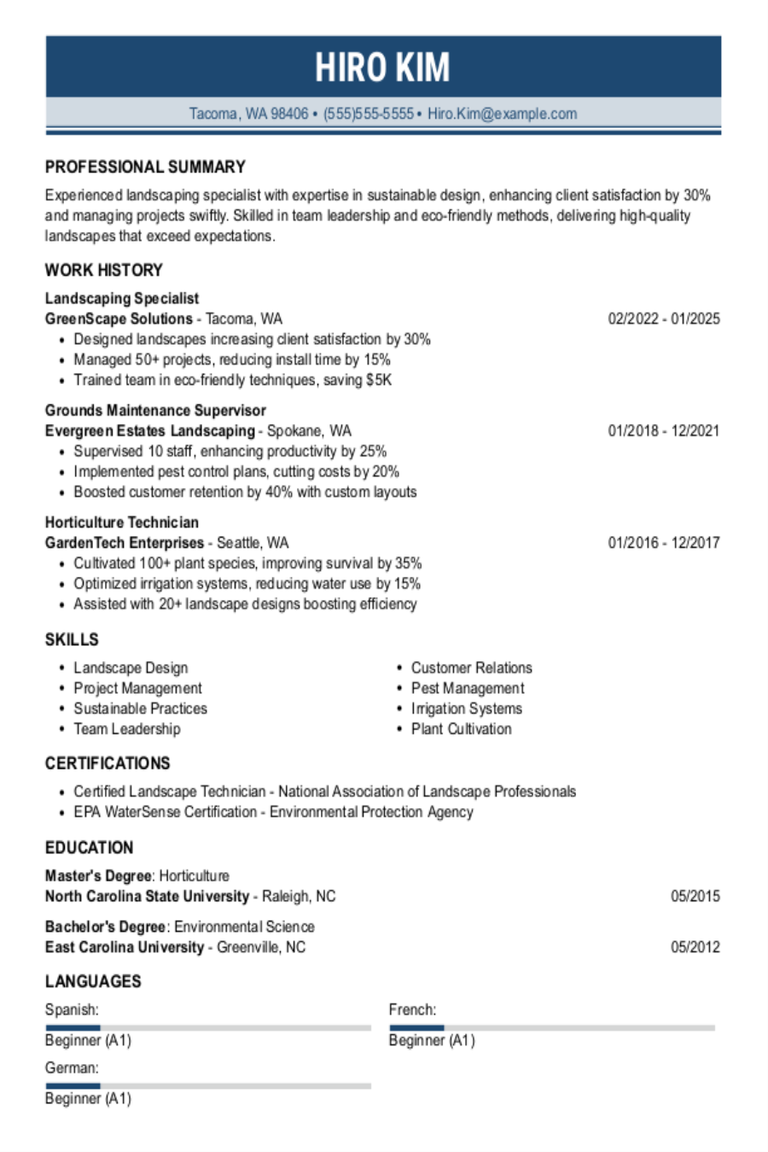
Landscaping Resume Examples & Templates for 2025
Explore landscaping resume examples to see how to showcase your gardening and design skills. Learn how to highlight your experience with plants, tools, and outdoor projects to catch the eye

